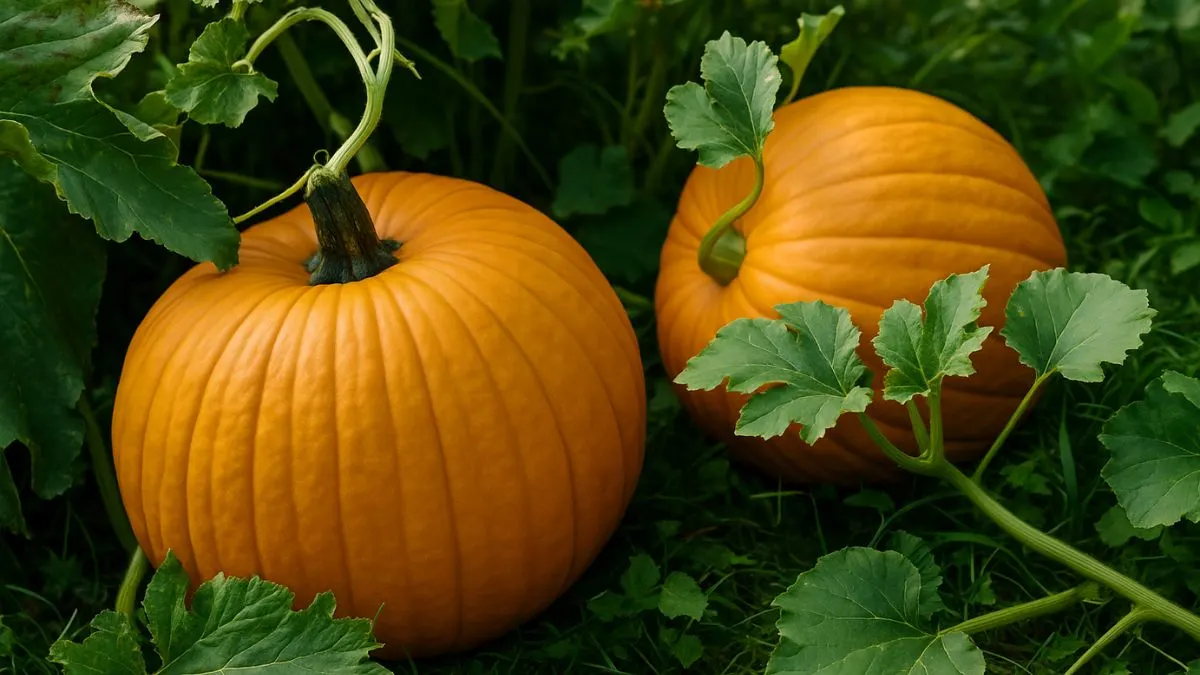Pumpkins are more than just vegetables—they’re icons of autumn. Whether you dream of carving glowing jack-o’-lanterns for Halloween, baking pumpkin pies for Thanksgiving, or simply enjoying their vibrant presence in your garden, pumpkins bring a festive charm like no other.
The good news? Growing pumpkins at home isn’t as complicated as it looks. With the right timing, soil preparation, and care, anyone can enjoy a bountiful harvest. Let me take you through this step-by-step guide, including lessons I’ve learned from my own pumpkin-growing journey.
Step 1: Timing Your Planting

When it comes to pumpkins, timing is everything. You can either sow pumpkin seeds indoors in April or directly outdoors in May, depending on your region’s frost dates.
In cooler climates like Canada, starting seeds indoors gives the plants a head start. In warmer parts of the USA, direct sowing into the soil works perfectly. Just remember, pumpkins can be started indoors or sown directly into the garden soil, but always after the risk of frost has passed.
Step 2: Preparing the Soil
Pumpkins are heavy feeders and need rich soil to thrive. The soil must be well drained, but moisture retentive, warm and in sunlight. Adding compost or well-rotted manure before planting gives them the nutrients they crave.
Choose a sunny spot, as pumpkins need full sun—at least 6 to 8 hours a day. Without enough light, your vines will grow weak and produce fewer fruits.
Also Read: How Often Should You Water Begonias?
Step 3: Planting the Seeds
Now comes the exciting part—planting! For larger varieties, make mounds or “hills” of soil and sow two to three seeds in each mound. For smaller options, follow this tip: Plant miniature varieties one inch deep, with two or three seeds every 2 feet in the row.
Thin seedlings once they sprout, leaving the strongest one or two plants to continue growing. This ensures better airflow and stronger yields.
Step 4: Temperature and Growing Conditions
Pumpkins love warmth. They need warm temperatures between 65 and 95 °F to grow properly. If the soil is too cold, seeds may rot before they germinate. Using black plastic mulch can help warm the soil faster in spring.
Once established, pumpkin vines spread quickly. Make sure to give them plenty of room to sprawl. A backyard garden bed or even a corner of your lawn can turn into a pumpkin patch.
Step 5: Watering and Maintenance
Pumpkins require consistent moisture, especially during fruit development. Deep watering is better than frequent shallow watering, as it encourages deep root growth.
Mulch around the plants to keep soil temperature stable and to reduce weeds. For gardeners short on space, you can even grow pumpkins vertically by training vines onto a sturdy trellis.
Also Read: How to Grow Watermelons for Juicy, Sweet Harvests
Step 6: Care Tips for Healthy Growth
Here are some additional pumpkin-growing tips:
- Rotate where you plant pumpkins each year to prevent soil-borne diseases.
- Hand-pollinate flowers if bees are scarce. (Sun + bees + well-drained sandy soil + water is the ultimate recipe for success!)
- Keep an eye out for pests like squash bugs and cucumber beetles.
Pumpkin Planting Quick Guide
Step |
Best Practice |
Seed Starting |
Sow pumpkin seeds indoors in April or directly outdoors in May |
Soil Requirements |
Well drained, but moisture retentive, warm and in sunlight |
Sunlight |
Pumpkins need full sun—at least 6 to 8 hours a day |
Planting Depth (Mini Var.) |
Plant miniature varieties one inch deep, with two or three seeds every 2 feet in the row |
Temperature |
They need warm temperatures between 65 and 95 °F |
Growing Method |
Pumpkins can be started indoors or sown directly into the garden soil |
My Personal Experience
The first time I grew pumpkins, I underestimated how much space they’d take over. Within weeks, the vines had crawled across my lawn, climbing fences and competing with other plants. But the joy of seeing the round, orange globes developing was worth every bit of the effort.
What surprised me most was how resilient they are. As long as you give them sunlight, water, and rich soil, they’ll reward you with an abundant harvest.
Also Read: How to Grow Strawberries for Juicy Harvests
Planting pumpkins is more than just gardening—it’s an experience that ties you to the season. Whether you want giant carving pumpkins or small decorative ones, the process is simple and rewarding. Start this season, and by autumn, your garden will be glowing with festive beauty.
🎃 Ready to grow your own patch? Grab some seeds, prepare your soil, and start your pumpkin journey today!






